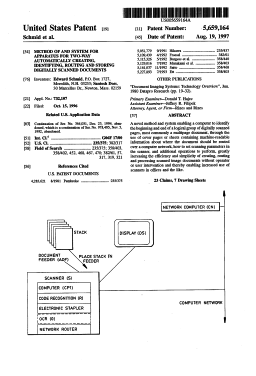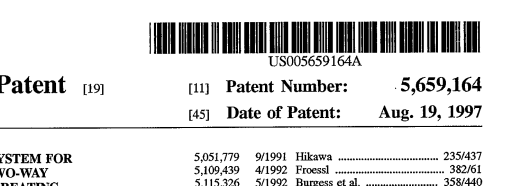This actually happened a long time ago, June 1998, but what the hell... I haven't written it anywhere before.
I was at work, at Marimba at the time, and I was scheduled to interview this fellow for a software engineering position. His name was Santosh Doss. And I'm checking over his resume... and lookee here, he's got a patent.

I was reading a lot of patents around that time, and I was probably writing my ARP Patents and my Moog Patents articles then. And also at that time, the IBM Patent Server was the tool to use, so I used that to track down his specific patent so I could look it over.
US Patent 5,659,164:
Method of and System for Apparatus for Two-Way Automatically Creating, Identifying, Routing and Storing Digitally Scanned Documents
Inventors: Edward Schmid, Meridith NH; Santosh Doss, Newton, MA
Filed: Oct. 15, 1996
Granted: August 19, 1997
It's a scheme for doing a batch operation, scanning a stack of paper
documents on a document scanner with a feed mechanism, and
distributing the resulting images to local files, remote files, email,
and so forth. Each document can be one or more pages long. The
patented part is a bar code sticker that is placed in the corner of
the first page of each document in the stack, and so after scanning
each page, some software detects the presence of the bar code sticker,
knows that this is the first page of a new document in the stack, and
that it has finished with the previous document, and by reading the
bar code it can identify the document and route the resulting scanned
image bits to an appropriate place.
Okay, fine. It sounds pretty obvious, tagging the beginning of each item in a stack has been around forever in some form or another, and bar code stickers have always been designed to be recognizable by computer. So as such, this sounds like just another one of those obvious patents that should never have been granted.
But... notice anything funny? Take a closer look at the scan from the US Patent and Trademark Office (USPTO):

The image of the scanned patent page shows (and who can't see this coming...) a bar code sticker in the upper right hand corner.
Apparently the patent office has been using this very scheme for years. That would make sense, being that they clearly have a need to scan stacks of multi-page documents and deposit the resulting image bits into files.
During the interview I asked Santosh about this. I wanted to make sure that I had correctly interpretted the patent-speak of the text of the patent. Yep, that's exactly what the patent is for. I asked him if he had ever heard of the patent being used by anybody. He said that he hadn't. I then asked if he ever checked out the image of the patent from the USPTO? No, he hadn't. I told him what I found and we had a chuckle over it.
So, not only is the patent office eager to patent the obvious, they're eager to patent stuff that they already use. I mean, I can imagine walking into the patent office, pointing to a desk, and saying, "I'd like to patent that stapler there".
Now, I suppose it's possible that the bar code procedure could have been put into place after the patent was granted, and maybe Santosh could sue the patent office for the use of his invention that the patent office granted to him before using his invention. Or maybe the patent office uses the bar code stickers for some other, unrelated, application. It's hard to say. But still...

Post a comment
Thanks for signing in, . Now you can comment. (sign out)
(If you haven't left a comment here before, you may need to be approved by the site owner before your comment will appear. Until then, it won't appear on the entry. Thanks for waiting.)